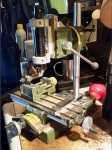
Originally Posted by
Murph1090

You guys break me up some days. You make a threaded threaded collar for the Dremel tool, one of you pisses away hours doing a single point thread on a lathe, the next goes on about the cost of the drill and tap, and I go buy a nut with the right thread and turn the flats off and weld or braze it in place. Might get really lazy, and not even turn off the flats.
Y'all forget the KISS principle in a heartbeat, makes me shake my head.
I've got a friend like that, every damn job requires it to done to show off his artistry, stroke his damn ego, and takes way too long to do. I don't ask him to do anything for me, he was doing a transmission rebuild for me and got pissed off when I walked over to my transmission, put a cupcake with a lit candle on it, and sang "Happy Birthday" to it! Told him in a year, he'd had more then enough time to git it done, time to get his thumb out of his ass and DO IT. Also told him be glad he's a friend; anyone else, I'd have taken a 2# mason's hammer and pounded the thumb in further, so he could feel up his tonsils!
It was done by week's end.
Murph


 LinkBack URL
LinkBack URL About LinkBacks
About LinkBacks


 Reply With Quote
Reply With Quote






Bookmarks